PrestaShop vs BigCommerce Comparison: Which one is Better?
In the era where online shopping is all the rage, store owners may feel overwhelmed with an abundance of Shopping Cart Software alternatives. It will be a shortcoming if people don’t mention PrestaShop and BigCommerce when it comes to eCommerce platforms.
They are both well-known but hold various features, and deciding which product is better can be such a nerve-wracking experience. We are here to help you save time in your process of choosing the best platform.
In today’s article, we will give you an in-depth comparison of PrestaShop and BigCommerce in terms of features, pricing, ease of use, support, integrations and adds-on, and security. Hopefully, you will figure out the best option for your shop after reading this article.
PrestaShop overview

First launched in 2007 in France, PrestaShop has become one of the world’s leading shopping cart solutions for many users. As of February 2021, this platform has around 702.304 websites that are PrestaShop customers, in which there are about 320.448 live websites using Prestashop and an additional 381.856 sites that used PrestaShop in the past.
PrestaShop is a free and open-source platform for store owners to create and run their business online. You can download and modify it as you prefer but it is not a completely free e-commerce solution. The source code is for free, yet, you need to pay for web hosting and probably several (often expensive) modules to integrate various functions to your site.

BigCommerce overview
BigCommerce is a paid-for, ‘hosted’ e-commerce platform that enables business owners to create an online store and sell their wares online. It means that you don’t need to buy web hosting or install anything on your computer to use it and all you need is a web browser and the Internet.
This platform provides you with a wide range of customizable templates to help you design and personalize your online store. BigCommerce is user-friendly and it does not matter if you are a tech-savvy user and able to do some HTML and CSS coding or you are an absolute novice in web design.
As of February 2021, there are roughly 146.545 websites using BigCommerce. To be specific, there are currently 52.510 live websites and addition of 94.035 sites that used the platform historically. As you can see, the number of BigCommerce users is much lower compared to that of PrestaShop.
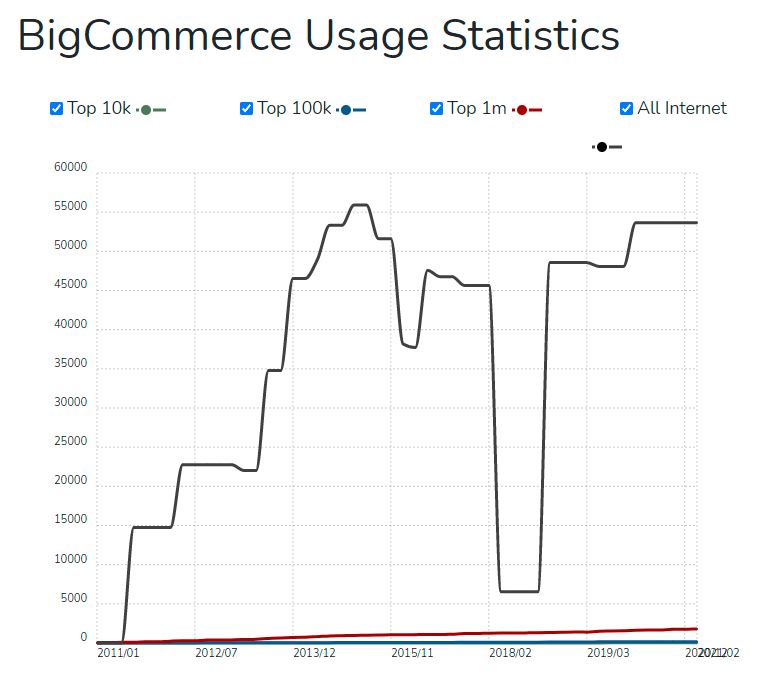
Compare PrestaShop vs BigCommerce
PrestaShop vs BigCommerce: Pros & Cons
There are several advantages and drawbacks when using the two platforms of PrestaShop and BigCommerce. Here are some positive and negative characteristics of them that you should take into account:
PrestaShop Pros
- PrestaShop is both easy and free to download; therefore, it is especially budget-friendly for new business owners.
- PrestaShop is highly customizable when it comes to adding and deleting features in a shopping site.
- PrestaShop supports various currencies and languages. Even though complete support is only available in English and French, the website can be translated into approximately 40 to 45 different languages.
- PrestaShop offers reliable, convenient, and secure payments such as PayPal, Google Checkout.
- There are many modules and themes available in PrestaShop (about 600 features with 1000+ modules and themes).
PrestaShop Cons
- The PrestaShop’s designs are believed to be rather unprofessional, especially for large-scale stores, even though it has all essential functionalities.
- Many add-ons in PrestaShop are prohibitive to purchase, at around £100+.
- When using PrestaShop, you need to have at least basic website developer skills.
- This platform has limited scalability and is only suitable for small and medium stores.
- PrestaShop experts and support teams are not available; however, there is a strong support community founded by its active users.
BigCommerce Pros
- There are excellent management tools ranging from order management to product management, facilitating your overall store management experience.
- BigCommerce provides you with great 24/7 support.
- There is a wide range of apps to choose from, including Quickbooks, Mailchimp, etc.
- There are no transaction fees when using BigCommerce.
- A 15-day free trial is offered for every new customer.
- BigCommerce holds great scalability, and it is suitable for both small and big online stores.
- BigCommerce is known for its solid and advanced SEO features.
BigCommerce Cons
- Free themes are rather limited and quite similar to each other. Meanwhile, some themes you wish to customize can be quite expensive, at around $145-$235 per theme.
- Since there is a limit on the amount of annual online sales, you will be forced to upgrade to a more costly plan in case of exceeding that threshold.
- Several paid apps are very expensive, at roughly $1000+ every month.
- The feature of the abandoned shopping cart is not accessible and needs to be paid.
- Finding the dropshipping apps that you need on the app store can be of great difficulty.
PrestaShop vs BigCommerce: Features
PrestaShop Features
Product management
Product management is one of the most significant features to consider when it comes to e-commerce stores. PrestaShop provides you with a robust and user-friendly product design and management system.
When starting out, you can create products quickly with some configuring features and setting values. With larger stores, you can create groups of products. PrestaShop supports all sorts of product variants and attributes, including digital products such as music, photographs, and electronic books, etc.
You can attach files or add any information needed to your product pages. Moreover, PrestaShop helps you ensure seamless product availability by allowing you to set a minimum quantity and sending you a message when there are any out-of-stock items.
Themes & Customization

You can start with the basic default theme on PrestaShop, which is free; however, it is rather basic and not likely to make your store appealing to viewers. In order to get access to multiple high-quality and responsive themes , you need to pay extra, often at steep prices, to attract more customers.
Suppose you have the technical knowledge or have help from a developer. In that case, you can get deep into the underlying code to customize your store’s functionality to suit your particular business objectives.
SEO
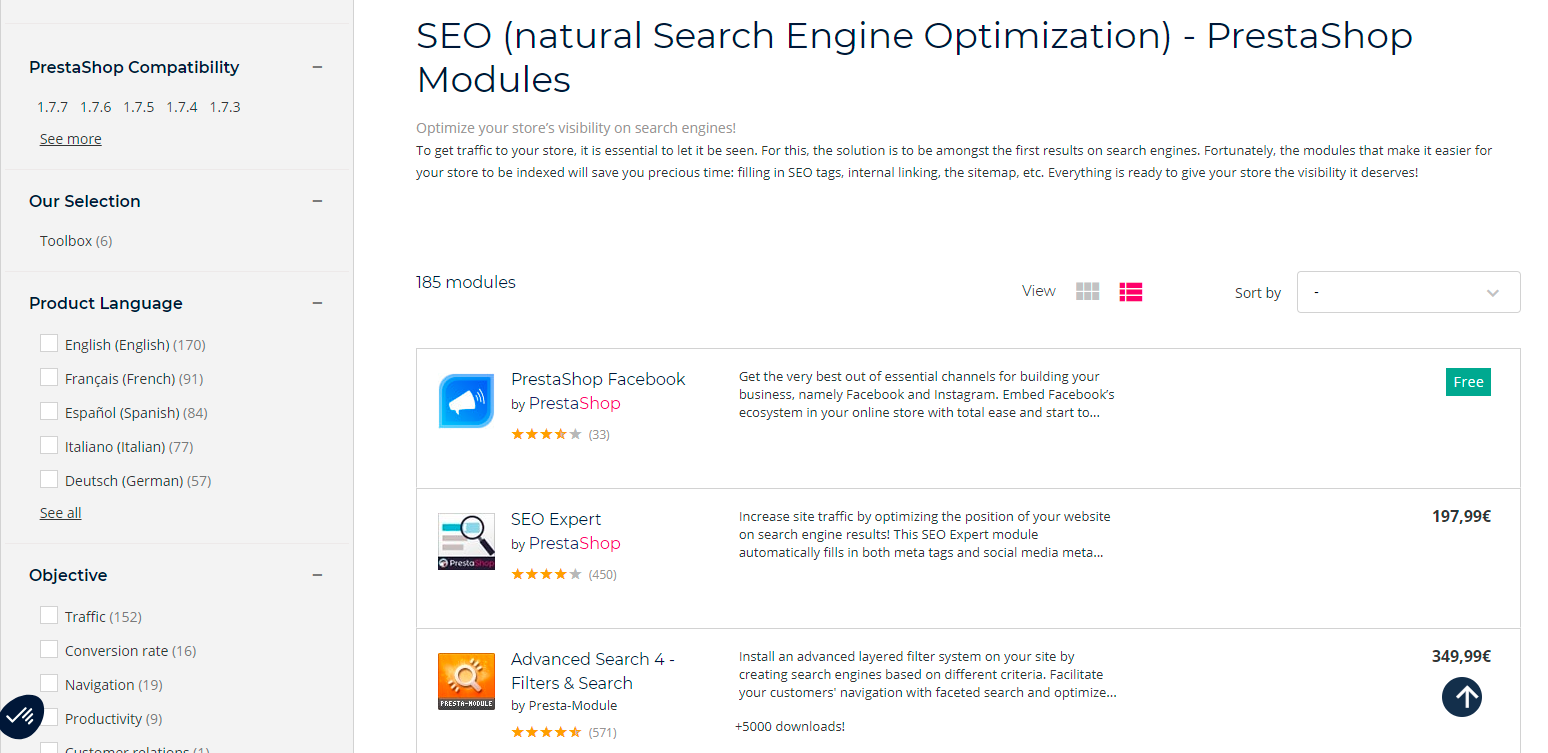
PrestaShop currently has more than 180 modules to help you in making your store outstanding and be among the top results on search pages. However, they can come at prohibitive prices, so you should make careful decisions about those additional modules.
Notably, PrestaShop SEO Audit hit top #1 with best SEO practices in 2020, and this incredibly good module can help you write perfect content for both search engines and users. In addition, you can track and analyze any SEO problems with the content on every web page of your website thanks to the continuously up-to-date algorithm of SEO Audit.
When using PrestaShop, you can adjust SEO title, meta description, permalink and generate friendly URLs automatically to get the most traffic.
Marketing
PrestaShop Ads, a smart marketing tool of PrestaShop, allows business owners to advertise all their products on multiple platforms such as Google Ads, Amazon Ads, Facebook, Instagram, etc. PrestaShop Marketing features also enable merchants to improve data feed quality, analyze competitors, and make detailed comparisons regarding prices and product quality, etc., and then help you map out better marketing strategies.
Payment Gateways
As for payment, PrestaShop provides you with a total of 250 options which are from the third-party processor or a merchant account with the PrestaShop Checkout Gateways. Besides, there is an extra service which is built with Paypal, and it offers various checkout types, such as American Express, Mastercard, Visa.
Third-party Tools
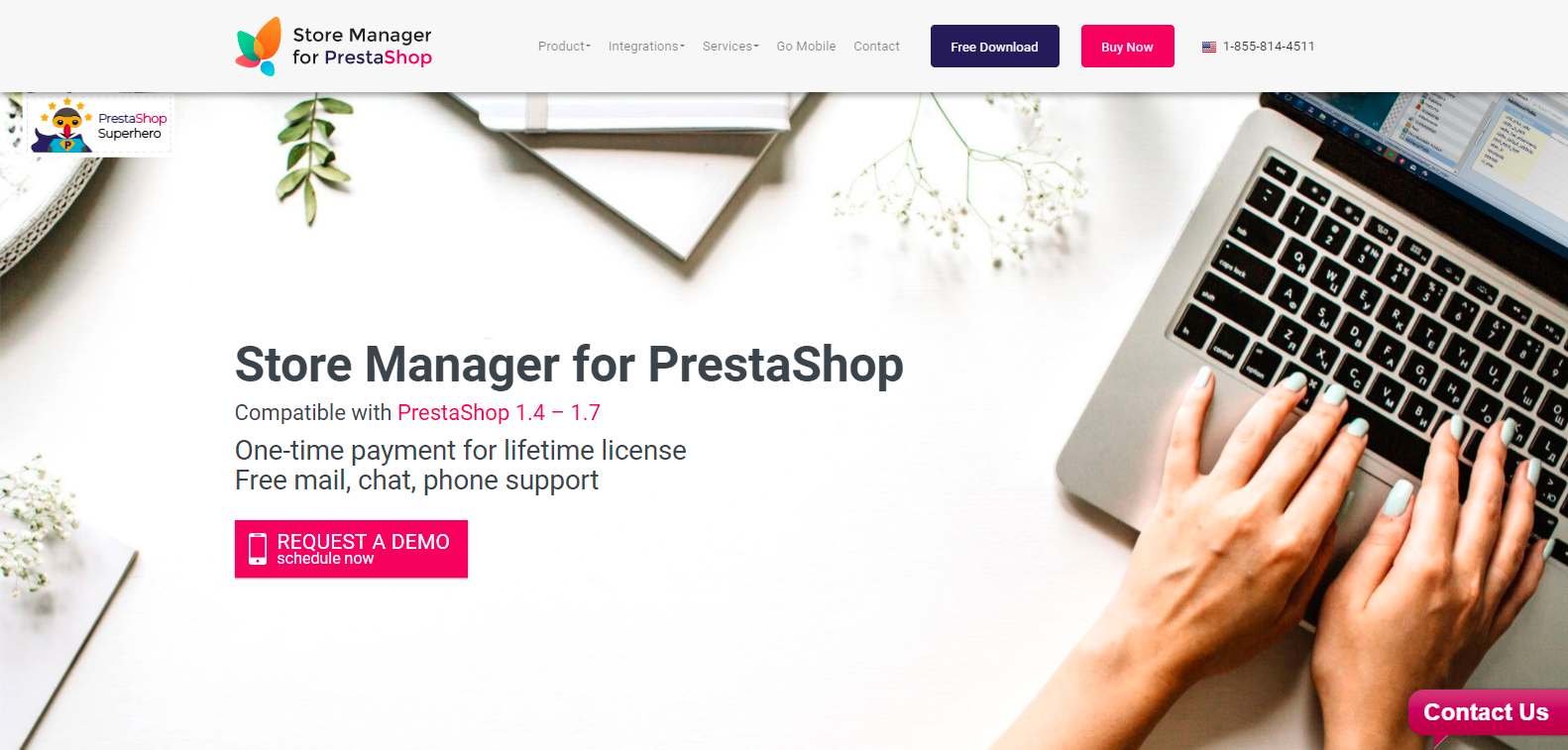
Because PrestaShop is open-source software, third parties can create tools to incorporate with the stock PrestaShop package. However, not all third-party tools are free and you may need licensing fees to get access to them.
One notable tool that PrestaShop offers is a Store Manager for PrestaShop . Here, you can manage all data, track customer activity, update inventory information, etc.
BigCommerce Features
Product Management
When using BigCommerce, you can import products, track and update your inventory, and also understand order trends over time, thanks to its seamless managing tools. It is also the only platform that allows you to sell products without paying for third-party apps.
Besides, you can adjust every little detail and information about your products to your own preferences. Themes & Customization
Themes & Customization
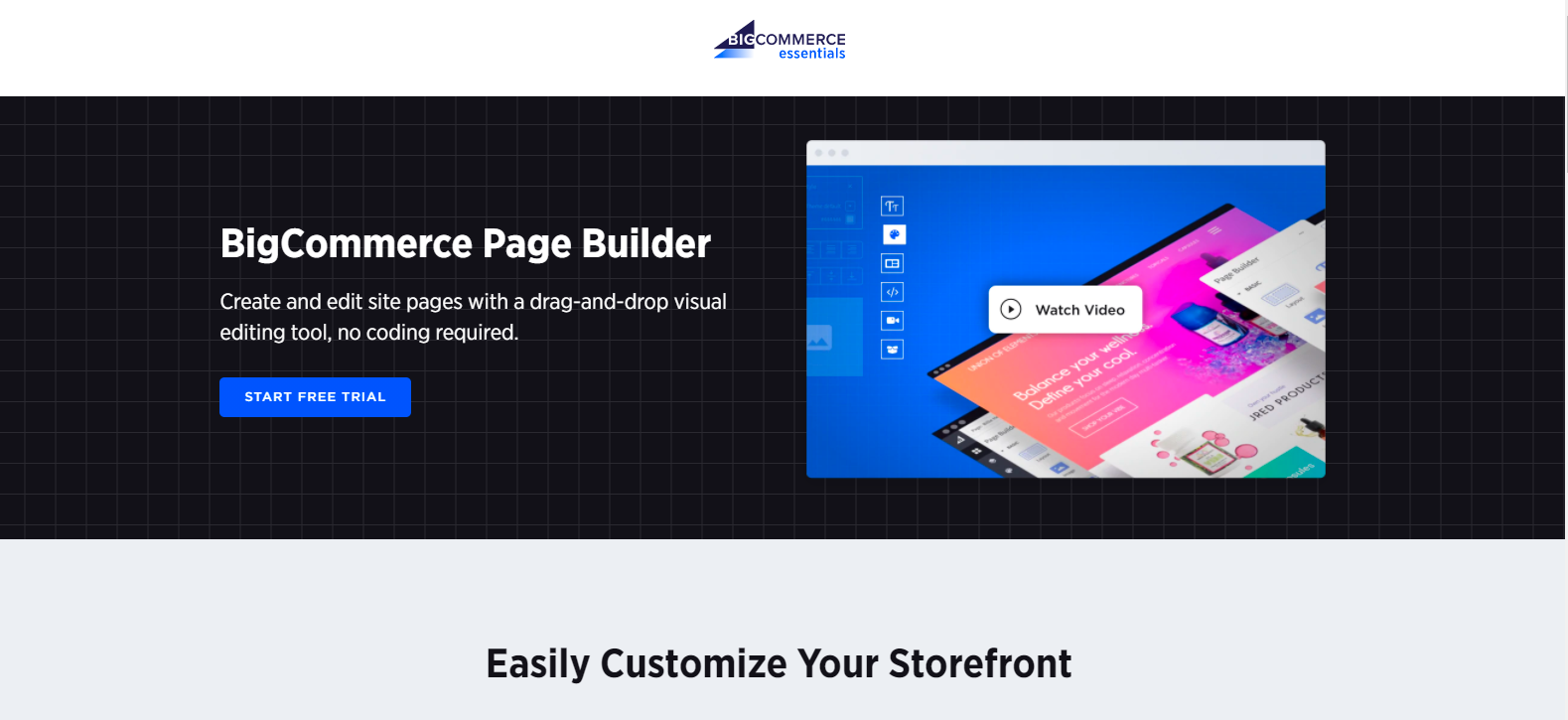
You can get access to different types and numbers of templates based on your varying budgets. 12 free themes are available to every new merchant, but with a budget between $145 and $235, there are more than 100 paid themes for you to choose from. You can play around with those themes without any coding skills because they are all responsive, stylish, and easy to customize.
Stencil is BigCommerce’s theme platform, which offers you state-of-the-art technology, design, conversion, and SEO practices. You can easily design and personalize your own online store all by yourself without much technical knowledge or ask for help from expert developers to customize all parts of your site. BigCommerce is essentially targeted at business owners who don’t have many website developing skills, but it also allows tech-savvy merchants to adjust their websites at their disposal by editing HTML, CSS, and other code libraries.
Besides, with the presence of the new page builder tool , you can also change many features of your storefront such as colors, fonts, carousel, sizes, logo positions, etc.
SEO
As you probably know, BigCommerce is known for its strong SEO feature. BigCommerce’s unique content delivery network allows your website pages to load faster than other stores; therefore, it improves customers’ overall shopping experience. Additionally, thanks to the built-in blogging function, you can upload blog posts and customize various details such as header tags, titles, URLs, etc… to make them as SEO-friendly as possible.
You can easily edit meta titles and descriptions, add image alt text, get keyword support, and create 301 redirects using BigCommerce. With the U.S platform, you can also get access to HTML and CSS code and advanced tools such as Schema, Sitemaps, and SSL.
The feature of Google accelerated mobile pages (AMP), as you know, plays a vital role in SEO performance and fortunately, many of BigCommerce’s themes are AMP-enabled by default, enabling merchants to have a lightning-fast product and category pages on mobile devices.
Marketing
There is quite a wide range of marketing tools that are available on BigCommerce. Those marketing tools can be free or charged at an additional cost.
Some of the major marketing features are banners, discounts, email marketing, abandoned cart recovery, and social media tools.
BigCommerce provides you with powerful tools like MailChimp, HubSpot, iContact, and Constant Contact so that you can build up a comprehensive list of customers and then automatically send emails, messages, newsletters to those targeted clients.
Besides, if a customer abandons the products in the shopping cart that they used to choose to buy, the feature of abandoned cart recovery will start to activate and send automated emails to those customers in order to get their attention once more time and hopefully get their purchase back. This feature comes in handy in plenty of situations and can contribute significantly to the rise of sales.
BigCommerce has the advantage of connecting your online stores with social media platforms. All you need to do is add the call-to-action button and direct your customers from Facebook, Instagram, Pinterest, etc., to your online stores on BigCommerce.
Payment Gateways
There are two options for payment gateways on BigCommerce, i.e., Paypal powered by Braintree and third-party payment processors. The default option of Paypal powered by Braintree is considered to be more beneficial than a third-party payment gateway considering its convenient one-page check-out and its rates for credit card transactions.
Mobile Commerce
With just a smartphone and Internet connection, you can manage your online business on the go and whenever you want, thanks to the BigCommerce Mobile App which can be downloaded from both Apple App Store and Google Play Store.
Some of the best features on the BigCommerce Mobile App include details about your store performance, a complete list of all your customers, a full catalog of your shop, and direct access to customers’ orders and updates.
PrestaShop vs BigCommerce: Cost
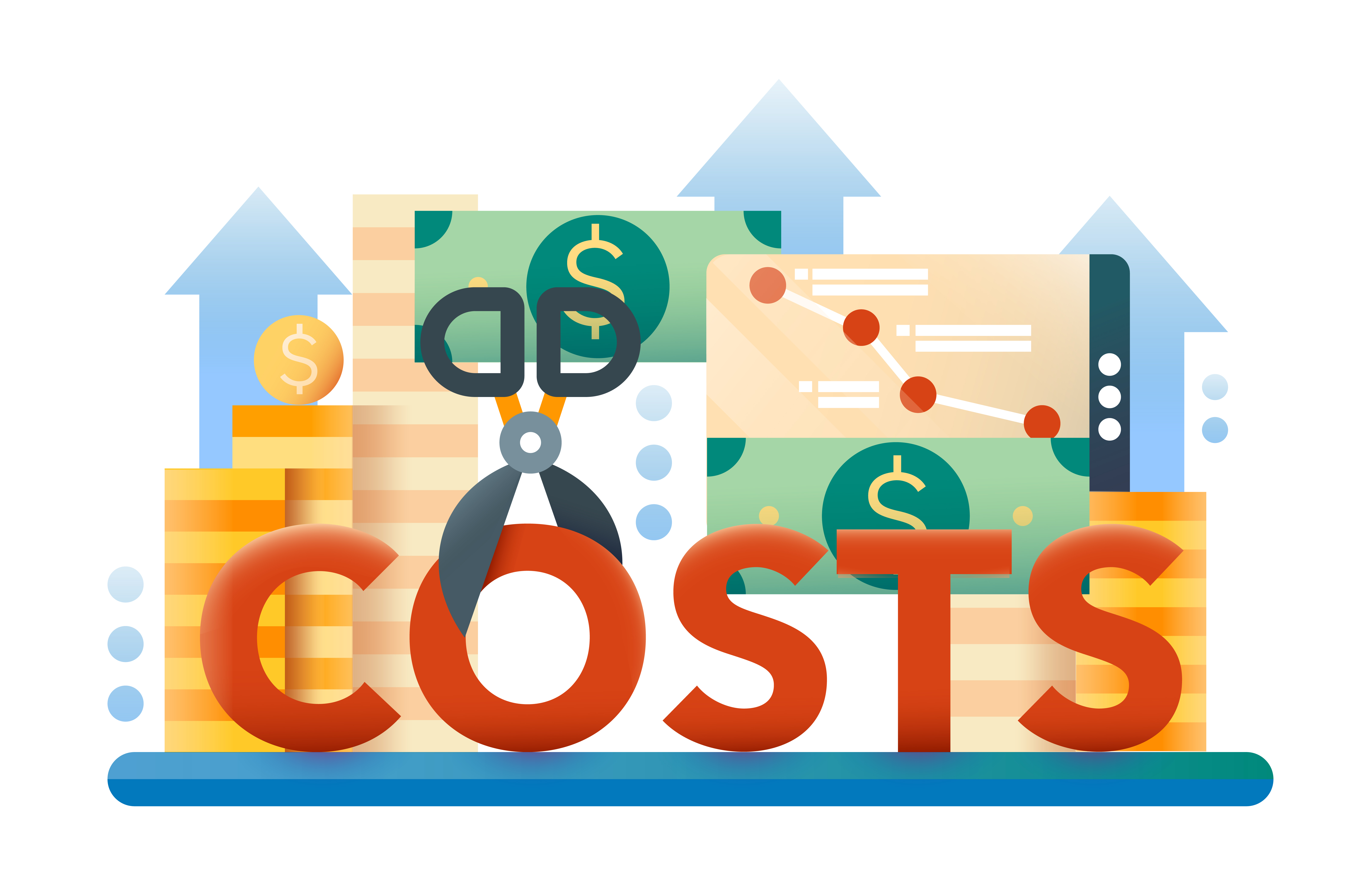
PrestaShop cost
Apparently, PrestaShop is favored by many because it costs $0 to download and set up a brand-new online store. Nonetheless, you need to take into account costs that would come up in the long run, such as hosting service, domain name, extensions, and plugins.
With the cheapest hosting options now available (shared hosting or cloud hosting), you need to pay around a few dollars a month; however, if you want to go for a more dedicated site hosting, it can cost you up to $100 each month.
You may need to pay less than $20 per year regarding the expense for a domain name. The security expense may cost you between $100-$500 for an SSL certificate.
Furthermore, modules and add-ons are often pricey on PrestaShop. You will see the costs start to add up gradually when using such extensions. The starting cost of integrating with QuickBooks, Amazon, eBay, Facebook, and TaxJar is $75, $75, $65, $0, $110, respectively.
What’s more, is that you may need to hire web developers and designers as PrestaShop can be challenging to set up, and some modules are complicated to use and often interfere with one another.
However, you can try out PrestaShop after downloading it for free and see if it fits your needs. Even though it does not offer a free trial, you can check out a detailed demo available on PrestaShop and decide whether to purchase further paid functionalities or not.
BigCommerce cost
BigCommerce’s pricing model is subscription-based, but it does offer a free 15-day trial for new users, with no credit card required. Payments are collected every month, with no contract or cancellation fees. However, it’s worth noting that BigCommerce’s pricing levels are based on the annual online sales of your store. For example, if your shop earns more than $125.000 per year, you automatically fall under the pro plan. Your pricing level will be automatically updated to the next tier if your company’s sales revenue is higher than the amount set before.
Basically, there are three main pricing plans on BigCommerce: Standard, Plus, and Pro, starting from $39 to $399. Besides, BigCommerce provides you with Enterprise plans which are geared towards enterprise sites wishing to have more tailor-made and advanced functionalities.
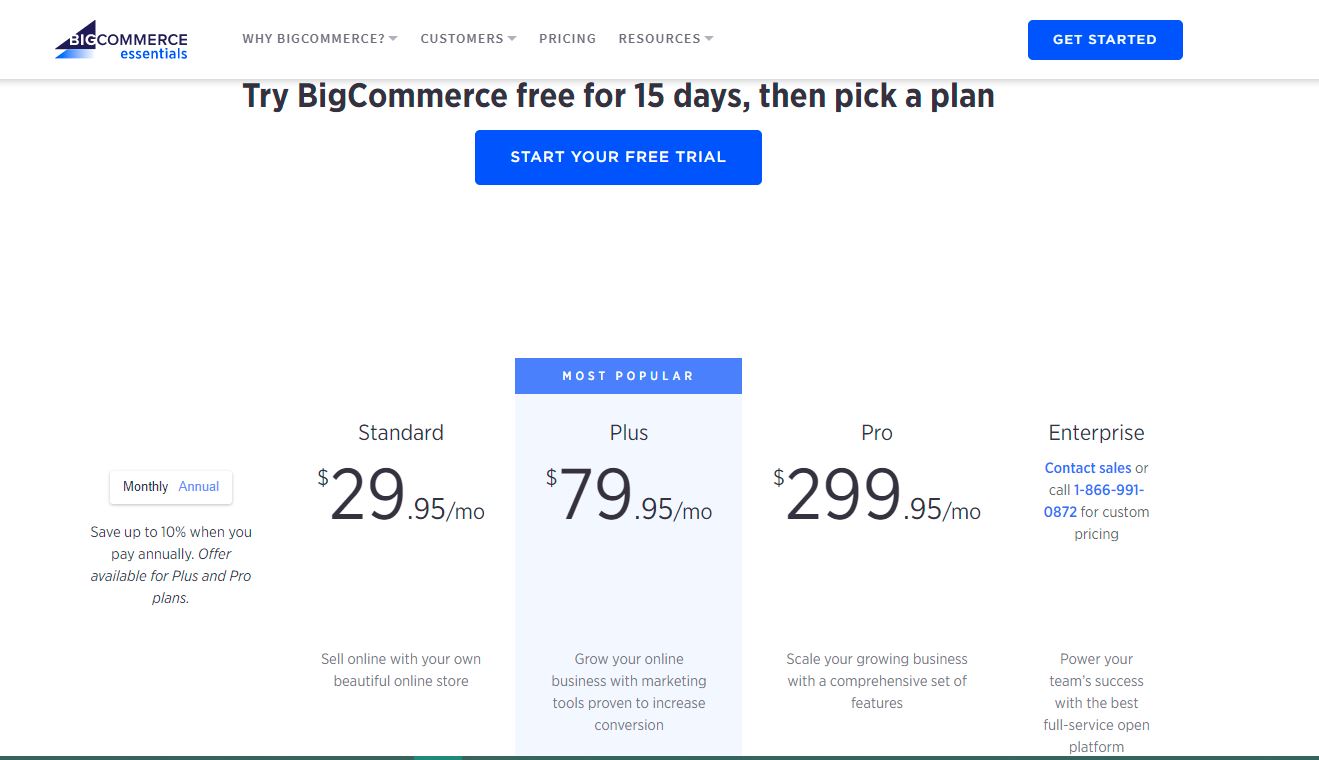
Different price types also come with varying Paypal transaction fees , so you should take this expense into account.
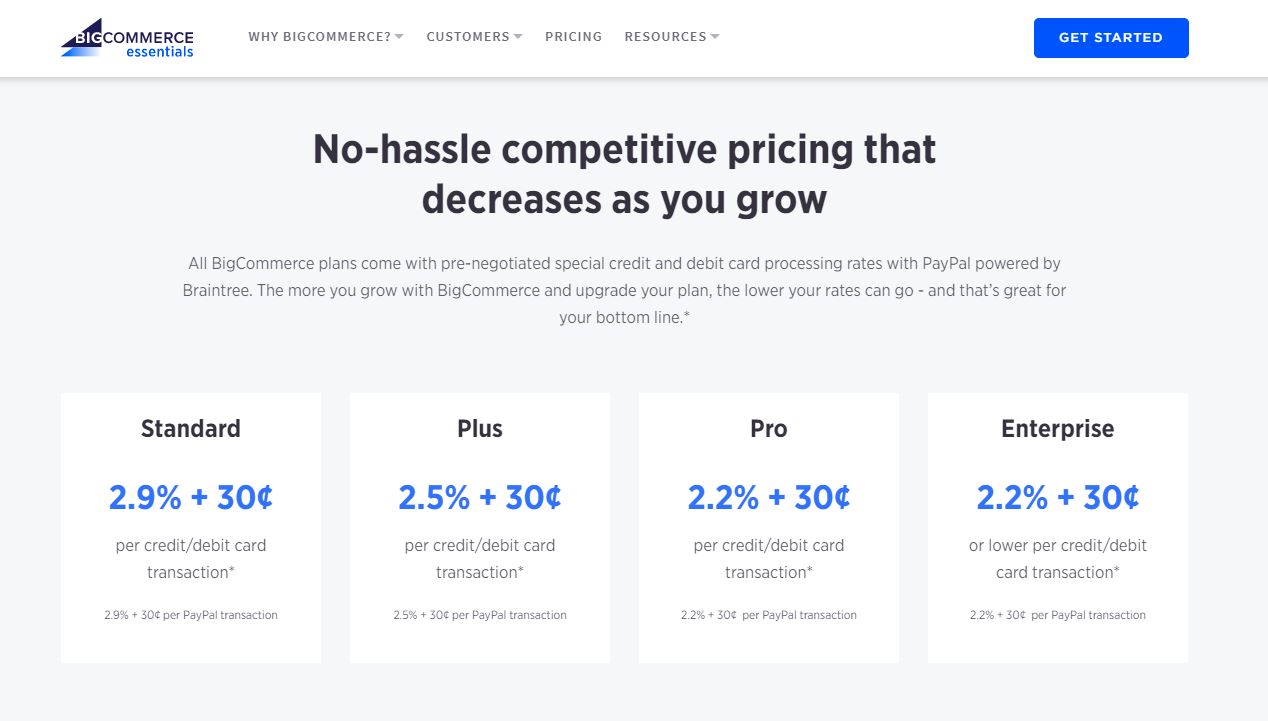
PrestaShop vs BigCommerce: Ease of use

In general, it is much easier to set up and use BigCommerce compared to PrestaShop.
BigCommerce’s dashboard requires little to no coding skills and provides a user-friendly interface that helps new merchants build their shops quickly and quickly.
After creating your account, you will receive an email directing you to your store’s admin. Here, you will find a list of to-dos on your main dashboard page, and you can click on each task to edit and adjust your product information, descriptions, images, inventory stats, etc. BigCommerce provides you with step-by-step instructions, tutorials, and tips so that shop owners like you can have a convenient and pleasant website development experience.
What about PrestaShop? It takes quite a lot of time and effort to set up your online stores on PrestaShop. You will have to download PrestaShop, build a database, use an FTP client to upload the program to your server, and then install it. More importantly, you will need to think about which modules you’ll need to run your company after that. This step can be challenging for those who have limited technical skills; therefore, it would be better to get help from professionals to take care of your integrations.
In short, while PrestaShop is open-source software that requires a few developer skills to set up at first, BigCommerce is a fully hosted platform that helps you set up a business quickly and easily, with little demand for tech skills.
PrestaShop vs BigCommerce: Customer Support & Technical Support

Generally, customer service and technical support from BigCommerce are better in comparison with PrestaShop.
Because PrestaShop is open-source software, there are multiple programmers developing the modules, templates, integrations, and add-ons. Therefore, it is particularly hard for PrestaShop to give users systematic support.
However, PrestaShop does offer a strong community of PrestaShop users that can help you solve your problem along with a host of paid services.
You can get free support from Help Center, Community Forum, Guides, Videos on Youtube. Some of the main paid services you should take into consideration are Quick Start Support, Web Ticket, Support Plans.
With Quick Start Support, you can only be assisted in installing your store on your chosen server and installing your store theme at the price of $241.
With Web Ticket, you need to send your questions to a PrestaShop professional and receive answers at a specific price. Normally, a complicated problem may take one hour on average to handle, which equals $115.
The support you get from Support Plans may be rather inadequate with regards to its cost. Except for the one-month $279.99 “Support Easy Plan,” all plans include a one-year commitment. The cheapest package, at $399, includes six hours of assistance a year. At $1,399, the most expensive service package includes 20 hours of support a year.
In contrast, BigCommerce offers 24/7 personal tech support via various channels. You can also get access to plenty of online self-help resources available on BigCommerce in order to solve problems on your own, at $0.
All users of BigCommerce can get support from all types of channels including phone, email, contact form, live chat, help center, community form, extensive guides online, a series of video tutorials, paid training sessions, blog, and even social media.
PrestaShop vs BigCommerce: Integrations and add-ons
PrestaShop: Integrations and Add-ons

There are approximately 4.000 integrations along with user reviews for each in PrestaShop’s Official Add-ons Marketplace . Most of them are available in many different languages other than English. Modules in Prestashop support a wide range of functions, including design and navigation, shipping and logistics, administration, promotion and marketing, and payment, etc.
PrestaShop has about free 150 add-ons and the usual price for each add-on would be $65. While the cheapest option is around $50, the highest-priced option is at $860.
As you can tell, those extensions and integrations cost you an abundance of money, however, it all depends on your business’s particular objectives and situation. You may want to purchase just a few of them to suit your needs or shift to another fully-hosted platform like BigCommerce to lower the cost.
Moreover, it’s worth noting that these third-party modules can create some unexpected glitches in your stores since some modules made by different developers may not work well together. Hence, keep in mind this drawback and read the reviews to make the right choice for your business.
BigCommerce: Integrations and add-ons
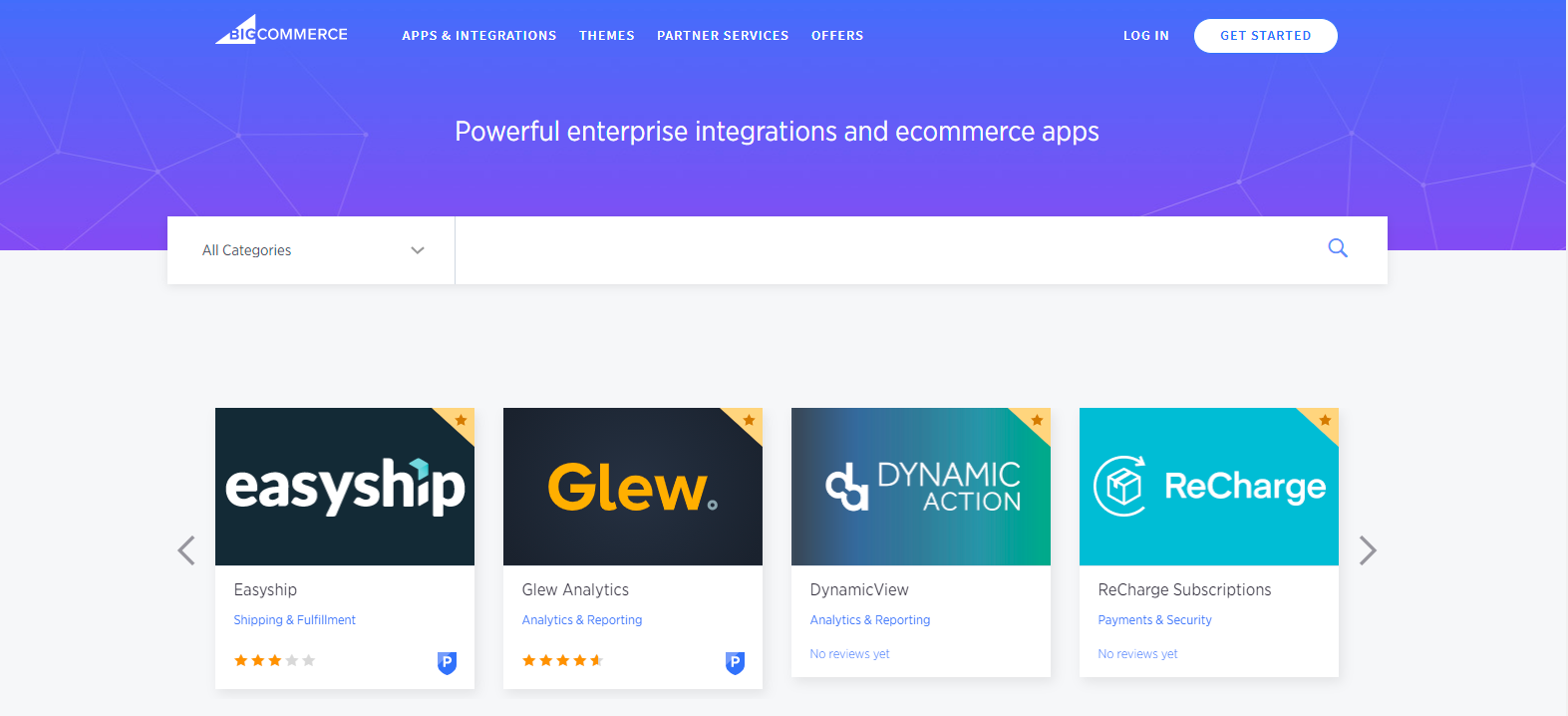
In case the built-in features on BigCommerce are not suitable for you, you can check out BigCommerce Apps Marketplace . Integrations are grouped into categories and subcategories for fast navigation. The majority of apps show user feedback so you should read the reviews carefully before choosing any integrations.
Currently, there are more than 880 add-ons available on BigCommerce and many of them are free to download and/or to use. However, keep in mind that applications that seem to be free at first may have a subscription fee attached later on. Therefore, make sure to read the pricing plan thoroughly.
As you can see, BigCommerce App Store offers a smaller number of apps compared to PrestaShop. Nonetheless, it is mainly because of its advanced built-in features, and with BigCommerce, you can get access to lots of functionalities without concerning third-party issues like PrestaShop.
PrestaShop vs BigCommerce: Security
Overall, BigCommerce is much better than PrestaShop regarding security.
PrestaShop is PCI compliance-ready (PCI: Payment Card Industry). It means that your online store on PrestaShop will not be PCI compliant by itself, therefore, you will need to purchase an SSL certificate (SSL: Secure Socket Layer). Do not forget to keep tabs on security updates on a daily basis and take a look at several of PrestaShop’s free security modules.
On the other hand, BigCommerce has achieved Level 1 PCI DSS (Payment Card Industry Data Security Standard) certification. According to the pricing structure, all BigCommerce plan levels ranging from Standard to Enterprise now hold a dedicated SSL certificate. You can get an SSL certificate for free with Standard and Plus plans. Meanwhile, you need to pay an extra amount of money for an SSL certificate in the Pro and Enterprise plans.
Your URL field will appear more professional and reliable to customers with an SSL certificate when they visit your online shop.
Besides, BigCommerce’s software is also hosted on the Google Cloud Platform. Hence, BigCommerce customers would benefit from Google’s perimeter and server-specific firewalls, file integrity scanners, and intrusion detection tools. DDoS threats are also mitigated by Google’s servers.
Final words
You have a lot of options when it comes to choosing an e-commerce platform for your online business. The answer for whether BigCommerce is better than PrestaShop or not varies among merchants. Both of them are currently among the leading shopping cart software in the marketplace and it is you who makes the call.
Even though PrestaShop is not really suitable for beginners with limited technical knowledge, if you still find PrestaShop suits your business’s objectives and strategies, you can hire a developer to help you work on the open-source software. It is free to download, so just try it out and see if PrestaShop is right for you or not. Try to make the most out of its features, functionalities, and its active user community to build your very first PrestaShop store.
Aimed at non-technical beginners, BigCommerce offers a host of great built-in features. However, keep in mind that BigCommerce will automatically upgrade your pricing plan based on your sales volume as I have mentioned.
All in all, we would say that PrestaShop is better for startups and small businesses, meanwhile, BigCommerce is the right call for medium and large enterprises. Just think thoroughly about your business type and goals to determine which one is right for you.
Related Posts:





